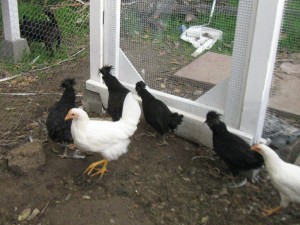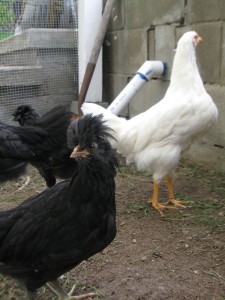In the first Steemjammer book, chickens are an important part of the family’s life. The Steemjammers are very independent and make and grow everything they need in their large yard and workshop-like house (except for a few things). Because it’s a novel, we only learn about the chickens briefly, but my family and I have been keeping chickens in our backyard for several years now. And I’d like to share a little of that experience with you.
A few years ago, my wife found out it was legal to keep backyard chickens in our city. She also found out that it was easy to make your own incubator and that fertile eggs from Trader Joes (and other stores) could be hatched! Really? I had to see this, so we got to work on the project – well, my wife mostly did. We learned a lot from a site called BackYardChickens.com, which I recommend, and we converted a Styrofoam ice chest into an incubator.
It had a cheap computer fan from an electronics store, a light socket for a 40w (small) bulb (incandescent – the kind that throw off heat – hard to find now), a dish for water and sponges (humidity), and a cheap water heater thermostat from a large hardware store. The thermostat normally had a wide range, over 4 degrees, so we had to have the distance from the bulb just right, which had the effect of narrowing its upper and lower range to about 2 degrees. We had the temp going from around 99 deg F to 101 deg F – or thereabouts. Many factors messed with this, and we panicked when it got too low or too high – but it was never too low or too high too long, as some of the eggs were viable and kept developing.
The eggs were in a carton, and we had to reach in at least 3 times a day to turn or move them (this keeps chicks from sticking to the shells). My wife candled the eggs (a halogen flashlight in a dark room) and found that about six of the dozen we’d started with were duds. We’d find later that they probably had bad air sacs. They were also a little old (9 days old). Fertilized eggs at TJ have a 3-digit code on them indicating the day they were laid, but it’s in the Julian calendar – Google how to make sense of this (it’s a long explanation). Anyway, eggs under 10 or 11 days old that have been in a cold case at 39 deg F will hatch – or some will. This is because chickens lay eggs over days, which can be very cold in the spring, and then one goes broody and sits on them. The warmth at that point activates the eggs, and chilled eggs can hatch. But some TJ eggs have loose air sacs, which you can see with a strong light (candling), and I think six of our eggs probably had bad air sacs (or weren’t fertile) and were duds. We threw them out.
About 20 days in we went into lockdown, where the eggs are taken from the carton and put on paper towels and not turned. At day 21, iirc, they began hatching. One chick didn’t make it, but five chicks hatched and went into the brooder!
These TJ chicks, from large white fertile eggs, were yellow and adorable – and would grow up to be white Leghorns. We had them in a cardboard box on textured paper (if slick, they can damage their feet permanently). We had a light and a thermometer so there was a spot where they were 95 deg F or so, with room to get away from the heat. We made sure no vents aimed at them. Their little water dish had marbles in it, so they couldn’t get in it or drown. And we bought some starter mash (feed for chicks) from a feed store. They ate, drank and grew. Sadly, at 4 to 6 weeks, three of them turned out to be cockerels (males). One rooster might be allowed in our area, but they’re way too loud. I ran a Craigslist ad and gave them a man who had some no-name chickens in his yard that he wanted to breed into better egg-layers, and Leghorns are among the best at that. Our remaining hens, or pullets (young hens), were named Henny Penny and Flutters. My wife made a plywood and tar paper coop for them, plus a chicken wire run.
Leghorns lay maybe 250 eggs a year each (about 5 a week per bird), once they get going. It seemed to take forever for them to start laying, but they were actually fast (at about five months). Meanwhile, while they were growing up, my wife turned an old plastic cooler into a better incubator, with several fans and a new thermostat (that wasn’t so touchy and kept the heat in the correct range better). She used a dowel rod so we could turn the egg tray or rock it – to one side for part of the day – then to the other side – then back to the other side. Not opening it to turn the eggs helped keep the temperature steady. Also, I suggested we candle the eggs in Trader Joe’s this time before buying them. My wife said, “No way! I’m not going to look like an idiot doing that in a store!” But I argued how else are we going to get 12 good eggs with tight air sacs for our next batch. So, we looked like idiots and traded eggs from several cartons until we got 12 good ones.
This time, eight hatched. Six turned out to be boys, ugh. Gave them away to a group that locates animals, and these new girls were named Lily Lilac and Blue, after their leg tags. At that point we stopped hatching Trader Joe eggs and got into other breeds. Chickens don’t live very long (five years, sometimes longer), and we’ve already lost one of them. She got sick or was bitten by a black widow – we’re not sure. We took her inside and did what we could for her – we had some antibiotics for her – but it didn’t help, and we lost her. So, given that we’re not sure how much longer our original 3 birds will last, we’ve started with some more eggs from TJs. Two are being hatched (we hope) by a very small chicken called a Serama. The others we thought would be hatched by Lily, who’d seemed to go broody, but she didn’t sit on them. So, into the incubator they went – and we’ll see what happens.
This was a great experience for our family. The children help out with feeding and cleaning, and we know where our eggs come from now. Our eggs have thick whites and, when there are greens to feed the chickens, dark orange yolks (that are rich). Eggs from chickens that forage are lower in cholesterol and higher in good Omega oils (and are more nutritious). They taste better than store eggs, too. If you’re allowed to have chickens in your yard, I strongly recommend giving it a try. It’s not easy, but there are great sites like backyardchickens.com to advise you. It’s also not that hard, either, once you get them established. You check and feed them twice a day – and the mess doesn’t have to be cleaned all that often if you have the right system. Give it a try! Oh, the eggs in Steemjammer are many colors – some dark, chocolate brown – some green or blue. Egg shells range from white to tinted to brown to very dark brown (I think Barnevelders, an old Dutch breed, lay these) to green or blue (Aruacana or Easter Egger chickens). So far, ours lay white or tinted eggs – some tiny – some medium – some very large. I want to try dark brown and blue/green one day, though. The shell’s color doesn’t affect the egg’s taste, or so I’ve been told. Anyway, I wish you the best of luck, if you try this. I think you’ll enjoy it. We find it satisfying and fun (chickens are fun to watch, strangely – and they beat the heck out of 90% of what’s on TV!). John
Below are some photos.
The white hens are the Leghorns hatched from Trader Joes fertile eggs. The black ones are Crevecoeurs, an endangered breed from France. And that’s Jack, our dog, outside the run. The chickens ate all the grass in their run, so we have to let them out to forage or pick greens to give them.
This Leghorn has been eating and has a full crop – the lump on her chest. It’s just a crop full of food.


